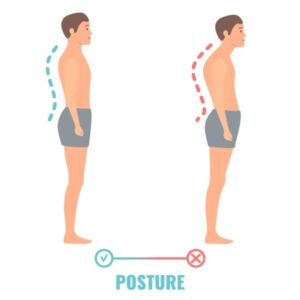
Poor posture, or postural imbalance, is the result of an inefficient allocation of body weight. A misaligned spine, poorly fitting shoes, hours spent slouched at a desk, or even sadness can all contribute to this problem. Posture can be classified as either static (when at rest) or dynamic (when in motion). When there is a mismatch between your static and dynamic posture, it can lead to discomfort or even damage.
For maximum strength and flexibility, your body relies on agonist and antagonist muscle pairs. Good posture will help you to improve your healthy habits. Overactive or underactive muscles, as well as shortened or lengthened muscles, can lead to postural imbalances that make it difficult to maintain correct alignment while seated, standing, or in motion. Pain Management Doctors can help you cope up with the pain and give you pain management regimens such as exercises.
Examples of Postural Imbalances:
● Sway Back Posture/ Hips out Forced to advance
This indicates that the hip flexors and lower abdominals are not performing to their full potential, resulting in a hyperactive posterior chain (glutes, hamstrings, and lower back). Stretching the hip flexors while kneeling, performing a figure 4 stretch, and using a foam roller on your hamstrings and back are all excellent ways to achieve this.
● Round Shoulders/Thoracic Kyphosis (shoulders round in front of the ear)
This is probably owing to weak middle-back muscles (at the level of the scapulae) and overly active chest muscles. As a kind of stretching, you can perform the bent-arm pectoral stretch while standing against a wall. A few examples of effective exercises for strengthening the upper body are the seated cable row, the resistance band back fly, the back deltoid cable rope pull, the overhand chin up, and the hanging scapular squeeze.
● Lordosis of the lumbar spine or lower crossed syndrome (Excessive lower back arch)
The pelvis(hip) is tilted forward in this position (APT). If the lumbar lordosis is growing, it is a sign of tight hip flexors and a rounded lower back. The glutes and lower abdominal muscles are weak, which contributes to this posture. Wearing elevated shoes, such as high heels or dress shoes, on a daily basis might cause excessive lower back arch. Kneeling hip flexor (upper thigh muscles) stretches and standing stretches, together with regular quadriceps foam rolling, can be helpful. Bridges, single-leg bridges, and the abdominal hollow are all excellent strengthening exercises.
● Syndrome of the Forward Head and Upper Cross Syndrome
The rhomboids and serratus anterior, which are located in the upper back, tend to be overactive, while the pectoral muscles (the front of the chest) tend to be underactive, leading to a rounded upper back and a forward head position. On the other hand, the suboccipital, levator scapulae, and upper trapezius which are neck muscles are tight, which contributes to a stooped posture caused by weak front neck flexors. Some effective stretches for improving your posture include straight-arm, bent-arm, pectoralis (chest muscles) depressors and stretches for the upper trapezius. Chin tucks performed repeatedly over time can assist in building endurance in the postural muscles, which are responsible for supporting the head and neck. Additional exercises include the seated cable row, resistance band back fly, rear deltoid cable rope pull, overhand chin-ups, and hanging scapular squeezes.
Make an appointment with our highly trained Pain Management Doctors and professionals at Doral Health and Wellness now if you are having pain in your knees, hips, hands, or spine as a result of bad posture. Professional doctors will help your upper back pain and promote middle pain relief. Through the use of certain exercises and other pain management regimens, they can assist you in alleviating upper back pain, shoulder pain, and other areas of the body. You may find it in Brooklyn at 1797 Pitkin Avenue, NY, 11212. You can take the bus or the train to get there. To get in touch, either dial 718-DORAL-55 or send an email to info@doralhw.org. A consultation can be scheduled, and you can begin living a pain-free life immediately.
